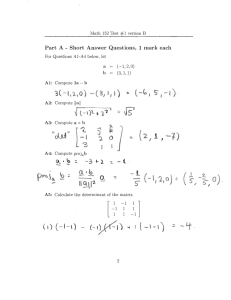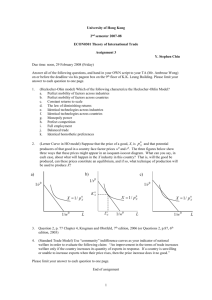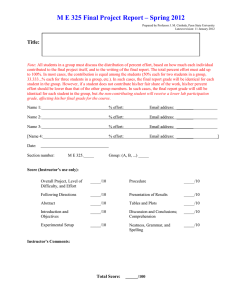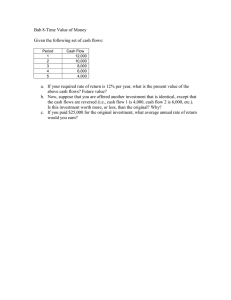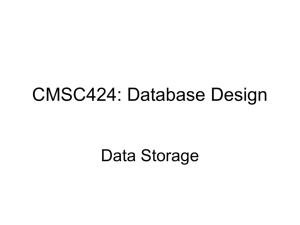Understanding Series and Parallel Systems Reliability
advertisement
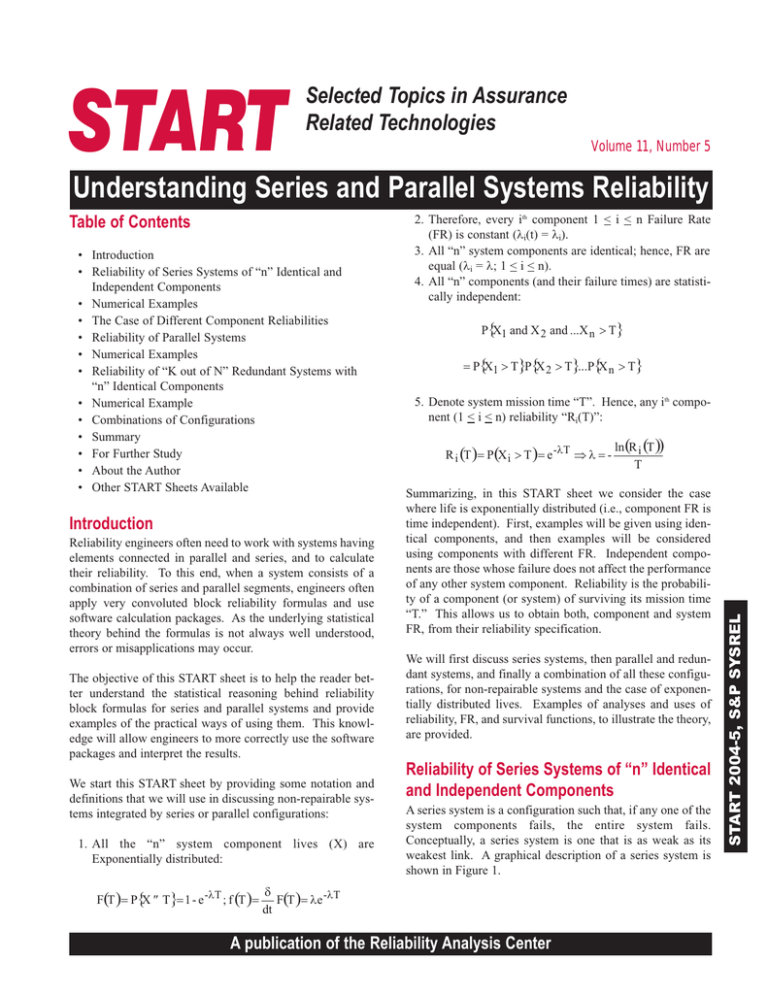
START
Selected Topics in Assurance
Related Technologies
Volume 11, Number 5
Understanding Series and Parallel Systems Reliability
• Introduction
• Reliability of Series Systems of “n” Identical and
Independent Components
• Numerical Examples
• The Case of Different Component Reliabilities
• Reliability of Parallel Systems
• Numerical Examples
• Reliability of “K out of N” Redundant Systems with
“n” Identical Components
• Numerical Example
• Combinations of Configurations
• Summary
• For Further Study
• About the Author
• Other START Sheets Available
Introduction
Reliability engineers often need to work with systems having
elements connected in parallel and series, and to calculate
their reliability. To this end, when a system consists of a
combination of series and parallel segments, engineers often
apply very convoluted block reliability formulas and use
software calculation packages. As the underlying statistical
theory behind the formulas is not always well understood,
errors or misapplications may occur.
The objective of this START sheet is to help the reader better understand the statistical reasoning behind reliability
block formulas for series and parallel systems and provide
examples of the practical ways of using them. This knowledge will allow engineers to more correctly use the software
packages and interpret the results.
We start this START sheet by providing some notation and
definitions that we will use in discussing non-repairable systems integrated by series or parallel configurations:
1. All the “n” system component lives (X) are
Exponentially distributed:
F(T )= P{X ≤ T}= 1 - e -λT ; f (T )=
2. Therefore, every ith component 1 < i < n Failure Rate
(FR) is constant (λi(t) = λi).
3. All “n” system components are identical; hence, FR are
equal (λi = λ; 1 < i < n).
4. All “n” components (and their failure times) are statistically independent:
P{X1 and X 2 and ...X n > T}
= P{X1 > T}P{X 2 > T}...P{X n > T}
5. Denote system mission time “T”. Hence, any ith component (1 < i < n) reliability “Ri(T)”:
R i (T )= P(X i > T )= e -λT ⇒ λ = -
ln (R i (T ))
T
Summarizing, in this START sheet we consider the case
where life is exponentially distributed (i.e., component FR is
time independent). First, examples will be given using identical components, and then examples will be considered
using components with different FR. Independent components are those whose failure does not affect the performance
of any other system component. Reliability is the probability of a component (or system) of surviving its mission time
“T.” This allows us to obtain both, component and system
FR, from their reliability specification.
We will first discuss series systems, then parallel and redundant systems, and finally a combination of all these configurations, for non-repairable systems and the case of exponentially distributed lives. Examples of analyses and uses of
reliability, FR, and survival functions, to illustrate the theory,
are provided.
Reliability of Series Systems of “n” Identical
and Independent Components
A series system is a configuration such that, if any one of the
system components fails, the entire system fails.
Conceptually, a series system is one that is as weak as its
weakest link. A graphical description of a series system is
shown in Figure 1.
δ
F(T )= λe -λT
dt
A publication of the Reliability Analysis Center
START 2004-5, S&P SYSREL
Table of Contents
1
2
•
n
R(T) = Exp{-(λ+λ+λ+ …+ λ)×T} = Exp{-n×λ×T}) = Exp{-λsT}
Figure 1. Representation of a Series System of “n”
Components
Engineers are trained to work with system reliability [RS] concepts using “blocks” for each system element, each block having its own reliability for a given mission time T:
RS = R1 × R2 × … Rn (if the component reliabilities differ, or)
n
RS = [Ri ] (if all i = 1, … , n components are identical)
However, behind the reliability block symbols lies a whole body
of statistical knowledge. For, in a series system of “n” components, the following are two equivalent “events”:
“System Success” ≡ “Success of every individual component”
Therefore, the probability of the two equivalent events, that
define total system reliability for mission time T (denoted R(T)),
must be the same:
{
} {
}
R(T) = P System ↔ Succeeds = P Comp1 and Comp2...and Comp n ↔ Succeed
{
} {
}
= P Comp1 ↔ Suc ...P Comp n ↔ Suc = R 1 (T) ...R n (T) = e
[
= R i (T )
-λT
...e
-λT
= (e
-λT n
)
]n = [Comp Reliability(T)]n = (e -λ ) nT = [R i (1)]nT = [Comp Reliability(1)]nT
The preceding assertion holds because Ri(T), the probability of
any component succeeding in mission time T, is its reliability.
All system components are assumed identical with the same FR
“λ” and independent. Hence, the product of all component reliabilities Ri(T) yields the entire system reliability R(T). This
allows us to calculate R(T) using system FR (λs = n×λ), or the
“n×T” power of unit time component reliability [Ri (1)]nT, or the
“nth” power of component reliability [Ri(T)]n, for any mission
time T. We will discuss, later in this START sheet, the case
where different components have different reliabilities or FR.
From all of the preceding considerations, we can summarize the
following results when all elements, which are identical, of a
system are connected in series:
1. The reliability of the entire system can be obtained in one of
two ways:
• R(T) = [Ri(T)]n; i.e., the reliability (T) of any component
“i” to the power “n”
• R(T) = [Ri(1)]nT; unit reliability of any component “i” to
the power “nT”
2. System reliability can also be obtained by using system FR
λs: R(T) = exp{-λσT}:
• Since λs = λ+λ+λ+ …+ λ = n × λ (all component FR λ
are identical)
2
System FR λs is then, the sum (“n” times) of all component failure rates (λ):
3. Component FR (λ) can be obtained from system reliability
R(T):
• λ = [- ln (R(T))] / n×T (inverting the reliability results
given in 1)
• Component FR λ can also be obtained from component
reliability Ri(T):
λ = - ln [Ri(T)]n / n×T = - ln [Ri(T)] /T
Previous expression is used for allocating system FR λs,
among the system components
4. Total system FR λs can also be obtained from 3:
•
λs = [- ln (R(T))] / T = - ln [Ri(T)]n / T
λs = n × λ remains time-independent in series configuration
5. Allocation of component reliability Ri(T) from systems
requirements is obtained by solving for Ri(T) in the previous R(T) equations.
6. System “unreliability” = U(T) = 1 - R(T) = 1 - reliability.
•
•
One can calculate the various reliability and FR values for the
special case of unit mission time (T = 1) by letting “T” vanish
from all the formulas (e.g., substituting T by 1). One can obtain
reliability R(T) for any mission time T, from R(1), reliability for
unit mission time:
R(T) = P(X1 ..., X n > T )= e -λsT = (e -λs ) T = [R(1)]T
Numerical Examples
The concepts discussed are best explained and understood by
working out simple numerical examples. Let a computer system
be composed of five identical terminals in series. Let the
required system reliability, for unit mission time (T = 1) be R(1)
= 0.999.
We will now calculate each component’s reliability, unreliability, and failure rate values.
From the data and formulas just given, each terminal reliability
Ri(T) can be obtained by inverting the system reliability R(T)
equation for unit mission time (T = 1):
R(1) = e -λs = (e -5λ ) = (e -λ ) 5 = [R i (1)]5 = 0.999
⇒ R i (1) = [R(1)]1 / 5 = (0.999)1 / 5 = 0.9998
Component unreliability is: Ui(1) = 1 - Ri(1) = 1 - 0.9998 =
0.0002.
Component FR is obtained by solving for λ in the equation for
component reliability:
λ=-
ln (R i (T) ) - ln (0.9998)
=
= 0.0002
T
1
We now calculate system FR (λs) and MTTF (µ) for the fiveengine system. These are obtained for mission time T = 10
hours and required system reliability R(10) = 0.9048:
λs = -
Now, assume, that component reliability for mission time T = 1
is given: Ri(1) = 0.999. Now, we are asked to obtain total system reliability, unreliability, and FR, for the (computer) system
and mission time T = 10 hours. First, for unit time:
R(1) = e -λs = (e -5λ ) = (e -λ ) 5 = [R i (1)] 5 = (0.999)5 = 0.995
= 0.010005 ⇒ MTTF = µ =
ln (R(T) ) - ln (0.995)
λs = =
= 0.005013
T
1
If we require system reliability for mission time T = 10 hours,
R(10), and the unit time reliability is R(1) = 0.995, we can use
either the 10th power or the FR λs:
R(10) = e -10λs = (e -λs )10 = [R(1)]10 = (0.995)10
1
= 99.96
λs
FR and MTTF values, equivalently, can be obtained using FR
per component, yielding the same results:
λ=-
Hence, system FR is:
ln (R(T) ) - ln (0.9048) 0.1001
=
=
10
10
T
ln (R i (T ) ) - ln (0.9802) 0.019999
=
=
= 0.0019999
10
10
T
⇒ λ s = ∑ λ i = 5 x λ = 5 x 0.0019999 = 0.009999 ≈ 0.01
∞
∞
0
0
⇒ MTTF = ∫ R (T )dT = ∫ e -λsT dT = µ =
1
= 99.96
λs
Finally, assume that the required ship FR λs = 5 × λ = 0.010005
is given. We now need component reliability, Unreliability and
FR, by unit mission time (T = 1):
R(1) = Exp{-λs} = Exp {-0.010005} = 0.99
= e -10λs = (e -10x0.00501 ) = e -0.05 = 0.9512
If mission time T is arbitrary, then R(T) is called “Survival
Function” (of T). R(T) can then be used to find mission time “T”
that accomplishes a pre-specified reliability. Assume that R(T) =
0.98 is required and we need to find out maximum time T:
R(T) = e -λsT = e -nλT = 0.98; ⇒ T = -
lnR(T)
ln(0.98)
== 4.03
λs
0.005013
Hence, a Mission Time of T = 4.03 hours (or less) meets the
requirement of reliability 0.98 (or more).
Let’s now assume that a new system, a ship, will be propelled by
five identical engines. The system must meet a reliability
requirement R(T) = 0.9048 for a mission time T = 10. We need
to allocate reliability by engine (component reliability), for the
required mission time T. We invert the formula for system reliability R(10), expressed as a function of component reliability.
Then, we solve for component reliability Ri(10):
R(10) = e -10λs = (e -10x5λ ) = (e -10λ ) 5 = [R i (10)]5 = 0.9048
= Exp{-5 × λ} = [Exp(-λ)]5 = [Ri(1)]5
Component reliability: Ri (1) = [R(1)]1/5 = [0.99]0.2
= 0.998
Component unreliability: Ui (1) = 1 - Ri (1) = 1 - 0.998
= 0.002
Component FR: λ = [- ln (R(1))]/n × 1 = [-ln(0.99)]/5
= 0.002
The Case of Different Component Reliabilities
Now, assume that different system components have different
reliabilities and FR. Then:
-λ T
-λ T -λ T
-TΣ i λ i
= e s ⇒ λ s = ∑ in=1 λ i
R(T) = R 1 ( T)...R n ( T ) = e 1 ...e n = e
Then system Mean Time To Failure, MTTF, = µ = 1/λs = 1/Σ λi
For example, assume that the five engines (components), in the
above system (ship) have different reliabilities (maybe they
come from different manufacturers, or exhibit different ages).
Let their reliabilities, for mission time (T = 10) be 0.99, 0.97,
⇒ R i (10 )= [R (10)]1 / 5 = (0.9048)0.2 = 0.9802
3
0.95, 0.93, and 0.9, respectively. Then, total system reliability
R(T) for T = 10 and FR are:
R (T )= R1 (T )...R n (T )= 0.99 x 0.97 x 0.95 x 0.93 x 0.9 = 0.7636
⇒ λs = -
ln (R (T )) - ln{R (10 )} 0.2697
=
=
0.02697
10
10
T
= 1 - P{X1 ≤ T}P{X 2 ≤ T}
[
-λ T
=1- 1- e 1
[ {
][
1- e
}] 2 = 1 -
=1- 1- P X > T
Since the system FR is λs = 0.02697, then the system MTTF is
µ = 1/λσ = 1/Σ λi = 1/0.02697 = 37.077.
-λ 2T
]
; If R1 (T) ≠ R 2 ( T) ⇒ λ1 ≠ λ 2
[
1- e
X1 > T
1
; If R 1 (T) = R 2 ( T )
X2 > T
Reliability of Parallel Systems
A parallel system is a configuration such that, as long as not all
of the system components fail, the entire system works.
Conceptually, in a parallel configuration the total system reliability is higher than the reliability of any single system component. A graphical description of a parallel system of “n” components is shown in Figure 2.
]
-λ T 2
X1 and X2 > T
Figure 3. Venn Diagram Representing the “Event” of Either
Device or Both Surviving Mission Time
This approach easily can be extended to an arbitrary number of
“n” parallel components, identical or different. By expanding
the formula RS = 1 -(1 - R1)×(1 - R2)×…(1 - Rn) into products,
the well-known reliability block formulas are obtained. For
example, for n = 3 blocks, when only one is needed:
RS = 1 -(1 - R1)×(1 - R2)×(1 - R3) = R1 + R2 + R3 - R1R2 - R1R3
- R2R3 + R1R2R3 or
2
2
3
RS = 1 -(1 - R)×(1 - R)×(1 - R) = 3R - 3R + R (if all components are identical: Ri = R; i = 1, …, n
n
Figure 2. Representation of a Parallel System of “n”
Components
Reliability engineers are trained to work with parallel systems
using block concepts:
RS = 1 - Π (1 - Ri) = 1-(1 - R1) × (1 - R2) ×… (1 - Rn);
the component reliabilities differ, or
if
Using instead, the statistical formulation of the Survival
Function R(T), we can obtain system MTTF (µ) for an arbitrary
mission time T. For, say n = 2 arbitrary components:
R(T) = 1 - [1 - R 1 (T)][1 - R 2 (T )] = 1 - 1 - e -λ1T 1 - e -λ 2T
= e -λ1T + e -λ 2T - e -(λ1 + λ 2 )T
RS = 1 - Π (1 - Ri) = 1-[1 - R] ;
if all “n” components are
identical: [Ri = R; i = 1, …, n]
n
However, behind the reliability block symbols lies a whole body
of statistical knowledge. To illustrate, we analyze a simple parallel system composed of n = 2 identical components. The system can survive mission time T only if the first component, or
the second component, or both components, survive mission
time T (Figure 3). In the language of statistical “events”:
() {
} {
}
R T = P System Survives T = P X1 > T or X 2 > T or BOTH > T
{
} {
} {
}
= R 1 (T) + R 2 ( T) - R 1 (T) x R 2 ( T )
[
]
[
][
[
][
] [ {
}][1 - P{X 2 > T}]
= 1 - 1 - R 1 ( T ) 1 - R 2 ( T ) = 1 - 1 - P X1 > T
4
∞
=
1
1
1
+
λ1 λ 2 λ1 + λ 2
Finally, one can calculate system FR λs from the theoretical definition of FR. For n = 2:
δ
- R(T)
Density Function
dt
=
FR = λ s =
Survival Function
R(T)
= P X1 > T + P X 2 > T - P X1 > T and X 2 > T
= R 1 (T) 1 - R 2 ( T ) + R 2 (T) + (1 - 1) = 1 + R 1 (T) 1 - R 2 ( T ) - 1 - R 2 ( T )
∞
⇒ MTTF = µ = ∫ R(T) dT = ∫ e -λ1T + e -λ 2T - e -(λ1 + λ 2 )T dT
0
0
]
λ e -λ1T + λ 2 e -λ 2T - (λ1 + λ 2 )e -(λ1 + λ 2 )T
= 1
≡ λ s (T )
e -λ1T + e -λ 2T - e -(λ1 + λ 2 )T
Notice from this derivation that, even when every component
FR(λ) is constant, the resulting parallel system Hazard Rate
λs(T) is time-dependent. This result is very important!
Numerical Examples
Let a parallel system be composed of n = 2 identical components, each with FR λ = 0.01 and mission time T = 10 hours,
only one of which is needed for system success. Then, total system reliability, by both calculations, is:
Reliability of “K out of N” Redundant Systems
with “n” Identical Components
A “k” out of “n” redundant system is a parallel configuration
where “k” of the system components, as a minimum, are
required to be fully operational at the completion time T of the
mission, for the system to “succeed” (for k = 1 it reduces to a
parallel system; for k = n, to a series one). We illustrate this
using the example of a system operation depicted in Figure 5.
R i (10) = P{X > 10}= e -10λ = e -0.1 = 0.9048; i = 1,2
The Probability “p” for any system unit or component “i”, 1 < i
< n, to survive mission time T is:
R(10) = 1 - [1 - R1 (10)][1 - R 2 (T)] = 1 - [1 - R i (10)] 2
R i (T )= P(X i > T )= e -λT = P
= 1 - (1 - 0.9048)2 = 0.9909
R(T) = e -λ1T + e -λ 2T - e -(λ1 + λ 2 )T = 2e -λT - e -2λT
Mean Time to Failure (in hours):
MTTF = µ =
1
1
1
2
1
+
=
= 150
λ1 λ 2 λ1 + λ 2 0.01 0.02
The failure (hazard) rate for the two-component parallel system
is now a function of T:
Component Operation Times
(Lives)
R(10) = 2e -10λ - e -20λ = 2e 0.1 - e -0.2 = 0.9909; for T = 10;
1
i
n
λ e -λ1T + λ 2 e -λ 2T - (λ1 + λ 2 )e -(λ1 + λ 2 )T
λ s (T) = 1
-(λ1 + λ 2 )T
e -λ1T + e -λ 2T - e
≡
0.02e -0.01T - 0.02e -0.02T
2e -0.01T - e -0.02T
This system hazard rate λs(T) can be calculated as a function of
any mission time T, as shown in Figure 4.
0.003
Time
Xi
Mission
Figure 5. Units Either Fail/Survive Mission Time
All units are identical and “k” or more units, out of the “n” total,
are required to be operational at mission time T, for the entire
system to fulfill the mission. Therefore, the Probability of
Mission Success (i.e., system reliability) is equivalent to the
probability of obtaining “k” or more successes out of the possible “n” trials, with success probability p.
This probability is described by the Binomial (n, p) Distribution.
In our case, the probability of success “p” is just the reliability
Ri(T) of any independent unit or component “i”, for the required
mission time “T”. Therefore, total system reliability R(T), for
an arbitrary mission time T, is calculated by:
Hazard(T)
0.002
0.001
R(T) = ∑ nj= k P(Succ. = j; Tot. = n; Unit Rel. = p )
0.000
0
10
20
Mission T
Figure 4. Plot of the Hazard λs(T) as a Function of Mission
Time T. Hazard Rate λs(T) increases as time T increases. This
plot can be used to find the λs(T) required to meet a Mission
Time of T. Say T = 10, then λs(T) about 0.0018
= ∑ nj= k C nj p j (1 - p )n - j = ∑ nj= k B(j; n, p )
n j
n− j
Sometimes the formula: 1 - ∑ kj=-10 C j p (1 - p )
is used instead.
This holds true because:
1 = ∑ kj=-10 C nj p j (1 - p )n − j + ∑ nj=k C nj p j (1 - p )n − j
5
The “summation” values are obtained using the Binomial
Distribution tables or the corresponding Excel algorithm (formula).
Following the same approach of the series system case, we
obtain the MTTF (µ).
R i (1) = 0.9 = e -λ ⇒ λ = - ln{R i (1)}
= - ln(0.9) = 0.105361
MTTF = µ =
R(T) = ∑ nj= k C nj e -λTj (1 - e -λT ) n − j ⇒ MTTF = µ
∞
∞
0
0
= ∫ R(T)dt = ∑ nj= k C nj ∫ e -λTj (1 - e -λT ) n - j dt =
1 n 1
∑
λ j= k j
We can obtain all parameters for an arbitrary T, by recalculating
probability p = e-λT of a component surviving this new mission
time “T”. In the special case of mission time T = 1, the “T” vanishes from all these formulas (e.g., substituted T by 1).
Applying the immediately preceding assumptions and formulas, we obtain the following results:
• The reliability R(T) of the entire system, for specified T, is
obtained by:
- Providing the total number of system components (n)
and required ones (k)
- Providing the reliability (for mission time T) of one
component: Ri(T) = p
- Alternatively, providing the Failure Rate (FR) λ of one
unit or component
• System MTTF can be obtained from R(T) using the preceding inputs and:
1 n 1
MTTF = ∑
λ j=k j
• The “Unreliability” = U(T) = 1 - Reliability = 1 - R(T)
Numerical Example
Let there be n = 5 identical components (computers) in a system
(shuttle). Define system “success” if k = 2 or more components
(computers) are running during re-entry. Let every component
(computer) have a reliability Ri(1) = 0.9. Let mission “re-entry”
time be T = 1. If each component has a reliability Ri(T) = p =
0.9, then total system (shuttle) reliability R(T), the component
FR (λ) and the MTTF (µ) are obtained as:
R(1) = ∑5j= 2 P(Succ. = j; Tot. = 5; Unit Rel. = 0.9)
= ∑5j= 2 C nj 0.9 j (1 - 0.9) 5- j
= 1 - ∑ 2j=-10 C nj 0.9 j (1 - 0.9) 5- j
= 1 - 0.00046 = 0.99954 = e -λs
6
1 n 1
1
1 1 1 1
x + + +
∑ =
λ j= k j 0.105361 2 3 4 5
= 9.491 x 1.283 = 12.177
Now, assume that a less expensive design is being considered,
consisting of n = 8 identical components in parallel. The new
design requires that at least k = 5 units are working for a successful completion of the mission. Assume that mission time is
T = 1 and the new component FR λ = 0.223144. Compare the
two system reliabilities and MTTFs.
First, we need to obtain the new component reliability Ri (T) = p
for T = 1:
R i (1) = P(X > 1) = e -λ = e -0.223144 = 0.79999 ≈ 0.8 = p
Proceeding as before, we obtain the new total system reliability
for unit mission time:
8
R(1) = ∑ C nj 0.8 j (1 - 0.8)8- j = 1 - ∑5j=-10 C nj 0.8 j (1 - 0.8)8- j
k =5
= 1 - 0.05628 = 0.94372 = e -λs
MTTF = µ =
1
1 n 1
1 1 1 1
x + + +
∑ =
λ j= k j 0.223144 2 3 4 5
= 4.481 x 1.283 = 5.7497
The cheaper (second) design is, therefore, less reliable (and has
a lower MTTF) than the first design.
Combinations of Configurations
Some systems are made up of combinations of several series and
parallel configurations. The way to obtain system reliability in
such cases is to break the total system configuration down into
homogeneous subsystems. Then, consider each of these subsystems separately as a unit, and calculate their reliabilities. Finally,
put these simple units back (via series or parallel recombination)
into a single system and obtain its reliability.
For example, assume that we have a system composed of the
combination, in series, of the examples developed in the previous two sections. The first subsystem, therefore, consists of two
identical components in parallel. The second subsystem consists
of a “2 out of 5” (parallel) redundant configuration, composed of
also five identical components (Figure 6). Assume also that
Mission Time is T = 10 hours.
R3
R1
R4
R5
R2
Subsystem
A
R6
R7
Subsystem
B
Figure 6. A Combined Configuration of Two Parallel
Subsystems in Series
This result immediately shows which subsystem is driving down
the total system reliability and sheds light about possible measures that can be taken to correct this situation.
Summary
The reliability analysis for the case of non-repairable systems,
for configurations in series, in parallel, “k out of n” redundant
and their combinations, has been reviewed for the case of exponentially-distributed lives. When component lives follow other
distributions, we substitute the density function in the corresponding reliability formulas R(T) and redevelop the algebra.
Of particular interest is the case when component lives have an
underlying Weibull distribution:
Using the same values as before, for subsystem, A (two identical
components in parallel, with FR λ = 0.01 and mission time T =
10 hours), we can calculate reliability as:
T
-
F(T ) = P{X ≤ T} = 1 - e α
R A (10) = 1 - [1 - R1 (10)][1 - R 2 (10)]
β
T
-
δ
β β-1 α
f (T ) = F(T ) =
T e
dt
αβ
= 1 - [1 - R i (10)] 2 = 1 - (1 - 0.9048) 2 = 0.9909
Similarly, subsystem B (“2 out of 5” redundant) has five identical components, of which at least two are required for the subsystem mission success. R3(1) = R4 (1) = R5 (1) = R6 (1) = R7(1)
= 0.9, for T = 1. We first recalculate the component reliability
for the new mission time T = 10 and then calculate subsystem B
reliability as follows:
R i (1) = P{X > 1} = e -λ = 0.9
⇒ λ = - ln{R i (1)} = - ln(0.9) = 0.105361
R i (10) = P{X > 10} = e -λT = p
Here, we substitute these values into equations 1 through 5 of
the first section and 1 through 6 of the second section and redevelop the algebra. Due to its complexity, this case will be the
topic of a separate START sheet. Finally, for those readers interested in pursuing these studies at a more advanced level, we provide a useful bibliography For Further Study.
For Further Study
1.
2.
3.
= e -0.105361x10 = e -1.05361 = 0.3487 = p
4.
R B (10) = ∑5j= 2 P(Succ. = j; Tot. = 5; p = 0.3487)
= 1 - ∑ 2j=-10 C nj 0.3487 j (1 - 0.3487) 5- j
= 1 - 0.4309 = 0.5691 = e -10λs
Recombining both subsystems, we get a series system, consisting of subsystems A and B. Therefore, the combined system
reliability, for mission time T = 10, is:
R(10) = R A (10) x R B (10) = 0.9909 x 0.5691 = 0.5639
β
5.
6.
Kececioglu, D., Reliability and Life Testing Handbook,
Prentice Hall, 1993.
Hoyland, A. and M. Rausand, System Reliability Theory:
Models and Statistical Methods, Wiley, NY, 1994.
Nelson, W., Applied Life Data Analysis, Wiley, NY,
1982.
Mann, N., R. Schafer, and N. Singpurwalla, Methods for
Statistical Analysis of Reliability and Life Data, John
Wiley, NY, 1974.
O’Connor, P., Practical Reliability Engineering, Wiley,
NY, 2003.
Romeu, J.L. Reliability Estimations for Exponential Life,
RAC START, Volume 10, Number 7. <http://rac.
alionscience.com/pdf/R_EXP.pdf>.
About the Author
Dr. Jorge Luis Romeu has over thirty years of statistical and
operations research experience in consulting, research, and
teaching. He was a consultant for the petrochemical, construction, and agricultural industries. Dr. Romeu has also worked in
statistical and simulation modeling and in data analysis of software and hardware reliability, software engineering, and ecological problems.
7
Dr. Romeu has taught undergraduate and graduate statistics,
operations research, and computer science in several American
and foreign universities. He teaches short, intensive professional training courses. He is currently an Adjunct Professor of
Statistics and Operations Research for Syracuse University and
a Practicing Faculty of that school’s Institute for Manufacturing
Enterprises.
For his work in education and research and for his publications
and presentations, Dr. Romeu has been elected Chartered
Statistician Fellow of the Royal Statistical Society, Full Member
of the Operations Research Society of America, and Fellow of
the Institute of Statisticians.
Romeu has received several international grants and awards,
including a Fulbright Senior Lectureship and a Speaker
Specialist Grant from the Department of State, in Mexico. He
has extensive experience in international assignments in Spain
and Latin America and is fluent in Spanish, English, and French.
Romeu is a senior technical advisor for reliability and advanced
information technology research with Alion Science and
Technology previously IIT Research Institute (IITRI). Since
rejoining Alion in 1998, Romeu has provided consulting for
several statistical and operations research projects. He has written a State of the Art Report on Statistical Analysis of Materials
Data, designed and taught a three-day intensive statistics course
for practicing engineers, and written a series of articles on statistics and data analysis for the AMPTIAC Newsletter and RAC
Journal.
Other START Sheets Available
Many Selected Topics in Assurance Related Technologies
(START) sheets have been published on subjects of interest in
reliability, maintainability, quality, and supportability. START
sheets are available on-line in their entirety at <http://rac.
alionscience.com/rac/jsp/start/startsheet.jsp>.
For further information on RAC START Sheets contact the:
Reliability Analysis Center
201 Mill Street
Rome, NY 13440-6916
Toll Free: (888) RAC-USER
Fax: (315) 337-9932
or visit our web site at:
<http://rac.alionscience.com>
About the Reliability Analysis Center
The Reliability Analysis Center is a world-wide focal point for efforts to improve the reliability, maintainability, supportability
and quality of manufactured components and systems. To this end, RAC collects, analyzes, archives in computerized databases, and publishes data concerning the quality and reliability of equipments and systems, as well as the microcircuit, discrete
semiconductor, electronics, and electromechanical and mechanical components that comprise them. RAC also evaluates and
publishes information on engineering techniques and methods. Information is distributed through data compilations, application guides, data products and programs on computer media, public and private training courses, and consulting services. Alion,
and its predecessor company IIT Research Institute, have operated the RAC continuously since its creation in 1968.
8

